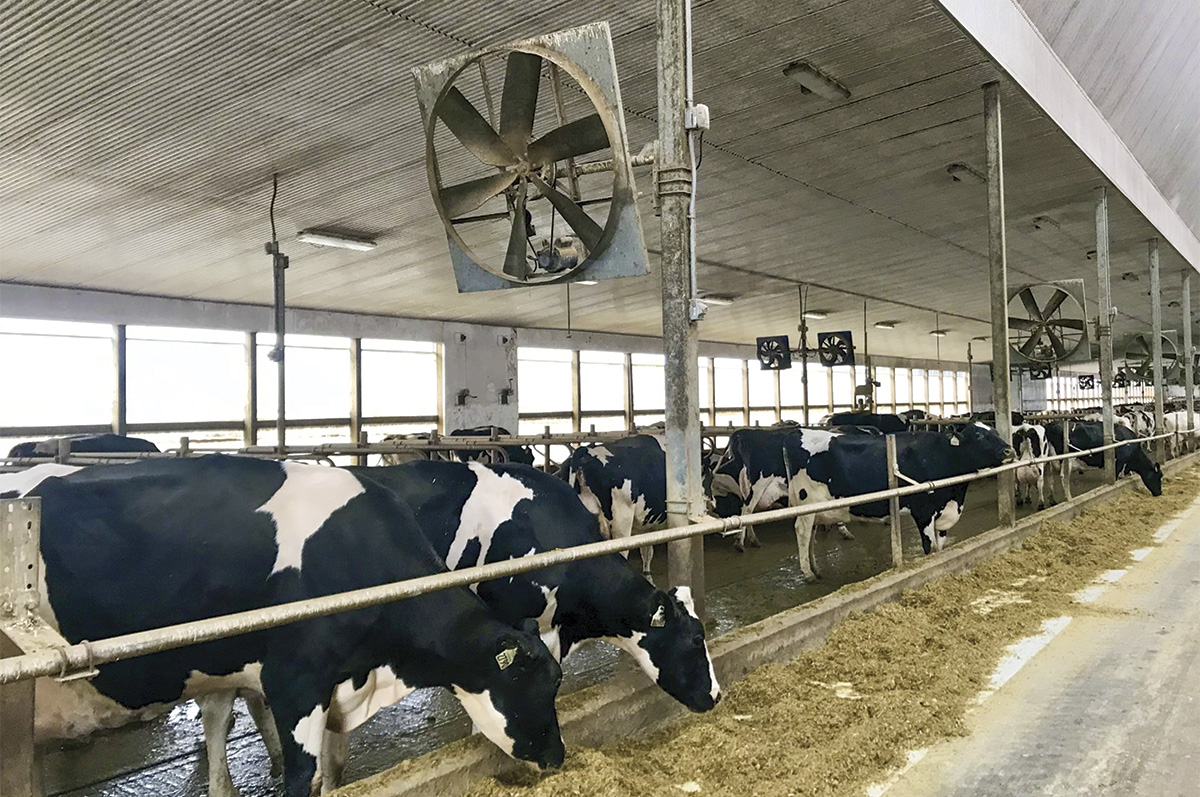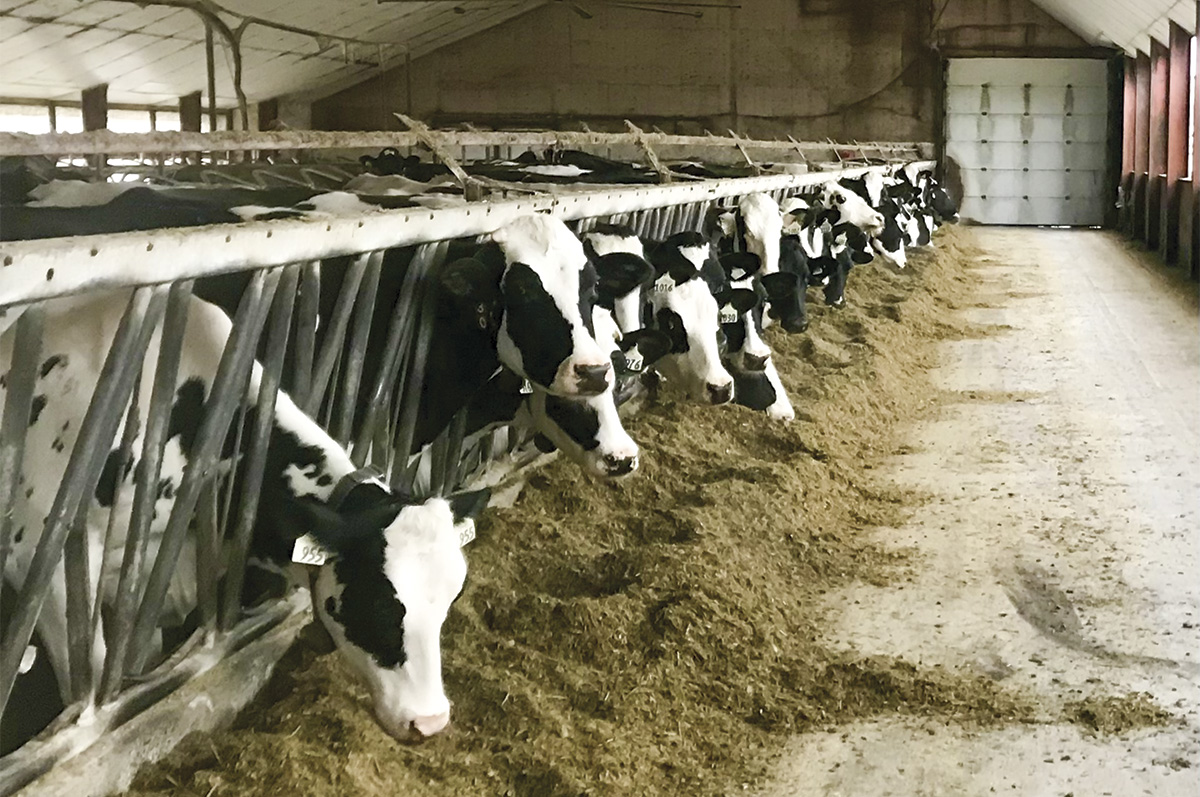The Novus C.O.W.S. Program has helped dairy farmers unlock bottlenecks in cow comfort and productivity across North America for over 12 years. The data collected during the program’s on-farm assessments is shared back to producers, showing how their results compare to over 1,700 anonymized assessments completed since the start of the program. While it’s not possible to share all the C.O.W.S. program results in one article, here you’ll find some of the management and facility factors that we’ve found are associated with higher milk production on Northeast and Midwest dairy farms.
HEAT ABATEMENT
Cows generate a lot of heat. A dairy cow producing 120 pounds (lbs.) of milk per day generates nearly 20 times the amount of heat as a human at rest. When cows are crowded into holding areas for three hours a day or more in the heat of summer, one can imagine the stress that they experience.
One way to support cow comfort and help manage heat stress is through ventilation. When it came to ventilation style, cross-ventilated barns rose to the top of the field in our database, with high groups averaging 104 lbs. compared to 92 lbs. and 88 lbs. for cows housed in tunnel-ventilated and naturally ventilated barns, respectively. In addition to barn ventilation style, farms that provided fans or fans and soakers in the high production pen had greater milk production than farms without.
Of note, cross-ventilated barns are a newer ventilation style and therefore more likely seen in newer builds in which stall dimensions may more closely follow recent recommendations. This could also be contributing to higher production due to increased cow comfort in those newer stalls.

Photo by Clem Nash.
Mechanical ventilation appears to have a slight advantage over naturally ventilated barns, but this does not mean naturally ventilated barns aren’t successful. A study that evaluated fan power observed that cows experiencing either fan treatment (60 percent fan power or 100 percent) had greater milk production, longer lying times, and lower vaginal temperatures than the no fan treatment, demonstrating that energy consumption can be reduced and still provide good cow cooling. No matter what barn ventilation style is used, ensuring that fans are on thermostats and directed to provide four to five miles per hour (mph) of airflow over the cows, whether they are lying or standing, is the best bet to reduce the impact of heat stress on cows. Lastly, it is critical that fans are cleaned and maintained twice a year for maximum airflow and performance.
Though it was difficult to tease apart sprinkler and soaker use and associated production results in our database, farmers who invest in cow cooling strategies are rewarded with higher milk production, and likely other productive benefits such as improvements to fertility and morbidity. The main takeaway: cool cows with every tool available.
FEED BARRIER DESIGN
When it comes to building a new facility, cow behavior should be a focus. We observed that farms that use headlocks as the feed barrier in their high pens had a 3.5 lbs. advantage over herds that used post and rail type barriers in their high pens. Even when breaking down various stocking densities by barrier design, pens with headlocks consistently had greater milk yields. Research explains this is likely due to headlocks reducing competition at the feedbunk: they provide protection from cow displacement, particularly for “at risk” cows such as those that are young, lame, or unwell.

Photo by Clem Nash.
An important note: While headlocks can provide protection, locking cows up should be limited to less than one hour per day. During assessments we have often observed, and even recorded, cows being locked multiple hours per day. Sometimes it was because the breeders have multiple pens to run through. Other times it was because someone just forgot to unlock the cows. Locking cows for two hours a day or more is linked to increased lameness, increased levels of mastitis, and reduced fertility, particularly when experienced by fresh cows.
FRESH COW MANAGEMENT
Speaking of fresh cows, how fresh cows are managed has an impact on milk yield. Farms that put their fresh cows in the same pen with sick cows had a 4.4 lbs. reduction in milk yield compared to farms that had a separate fresh pen, and 2.0 lbs. numerically lower than farms that sent cows straight into a lactating pen. While we can’t establish cause and effect with our database due to only taking one-time measurements, this could be because farms with separate fresh pens had different management styles than those that did not, contributing to these results. In general, it is best practice to have separate pens if possible, or to send fresh cows to a low-stocking-density milking pen instead of a hospital pen.
MILKING FREQUENCY
Unsurprisingly, milking frequency is also associated with milk yield. Cows milked three or four times per day produced an additional 10 lbs. of milk per day on average compared to cows milked only twice per day. No significant difference was observed between milking three or four times per day. With that said, a key factor when a farm is considering increasing milking frequency to increase production is parlor size and parlor efficiency. The costs to the cow of standing in a holding pen for more than 3.5 hours a day due to an additional milking may outweigh the potential benefits to production.
STALL CLEANLINESS
A sample of stalls is scored for cleanliness during C.O.W.S. assessments (1 = clean and dry, 2 = wet, 3 = soiled) and then the scores are averaged. While some variation is observed, each 1-unit increase in stall cleanliness (i.e. reduction in hygiene) was associated with a 4.7 lbs. reduction in milk. Ensuring proper and regular stall cleaning can help improve lying behavior and subsequently positively impact production and health factors.
CONCLUSIONS
While several factors contribute to higher production, farmers with high-producing herds follow a whole system and choose effective housing and management styles that work cohesively. Utilizing outside services, like the C.O.W.S. Program, can help identify bottlenecks that may not have been initially identified and support decision making to help reach a farmʼs goals.











